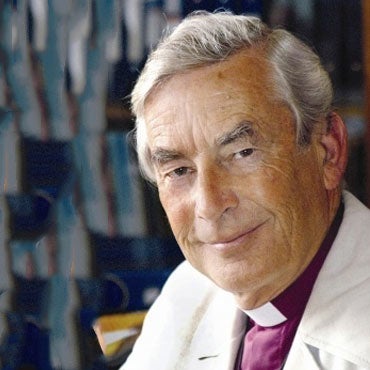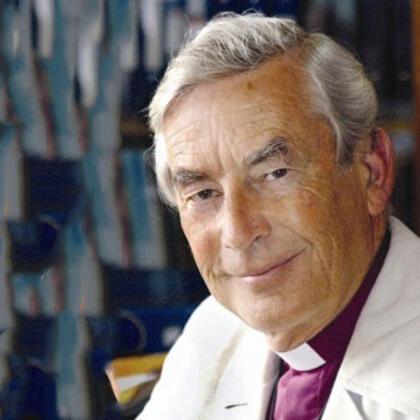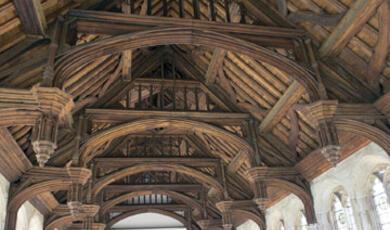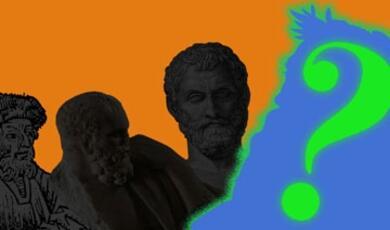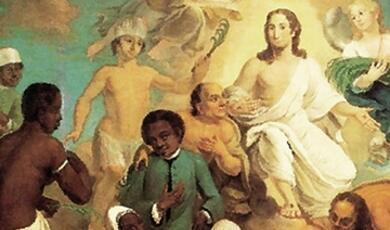The Pieta in Art
Share
- Details
- Text
- Audio
- Downloads
- Extra Reading
Many people are familiar with Michelangelo's masterpiece in the Vatican, of Mary holding the dead body of Christ in her lap. However Michelangelo's work was the culmination of many and varied representations of this scene over the centuries, and there are some highly evocative modern works of the same subject.
Lord Harries will explore the visual history of one of the most moving of all Christian images.
Download Text
31 March 2015
The Pieta in Art
The Rt. Rev Lord Harries
Michelangelo’s Pietà
Everyone is familiar with the Pietà of Michaelangelo. But how and why did this image come into being? It is not a scene that is described in the Gospels.
The Pietà is defined as a devotional image of the Blessed Virgin Mary mourning the dead Christ who lies across her lap. It developed in the 13th century and remained important in Christian devotion until the 17th. In German the word is vespebild. From the Latin word vespers, because the image was particularly associated with evening prayer, it being the evening of Good Friday when the body of Jesus was taken down from the cross. It is one of several devotional images (Andachtsbilder) that came into usage in Germany at very end of 13th century. The word Pietà means Pity in Italian but it was in Germany that the image originated.
The Gospels describe Crucifixion (El Greco), Deposition or descent from the Cross (Rubens), Laying on the ground (Epitaphios), Lamentation (Giotto), Entombment (Rogier Van de Weyden)
Michelangelo’s Pietà
A product of the religious imagination. But that is far too dry a description. It was from the first an image that expressed intense religious feeling and which was designed to arouse similarly intense feelings in others. Three general observations.
First, a distinction between narrative images, in which a figure is seen in relation to an incident in the Gospels, and a devotional one, where the figure is seen on their own as a focus for mediation and prayer. An example of a narrative image is Mary at the foot of the cross. This is a scene actually described in the Gospels (Icon). Although it has a devotional aspect, this is integrally related to its historical setting.
An example of the second, devotional type is The Man of Sorrows. Here the image is extracted from its historical setting. Jesus is simply set before the viewer to arouse devotion. This image originated in Byzantium as an icon and came to the West via Venice. This is an engraving by Israhel van Meckenem, made about 1490 It may not be to the taste of most people today. But this type of devotional image, The Man of Sorrows, has been described as the most precise visual expression of late mediaeval piety. It brought picture and viewer together with a religious intensity that has rarely been surpassed.
A Franciscan prayer book made in Genoa around 1300 identifies the prayers that were said in the West before the Byzantine image of The Man of Sorrows. One reads:
O how intensely thou embraced me, good Jesu, when the blood went forth from thy heart, the water from thy side, the soul from thy body. Most sweet youth, what hast thou done that thou should’st suffer so? Surely I, too, am the cause of thy sorrow.
The Man of Sorrows is an image for pure contemplation, as has been written:
New emotional qualities characterise the Western Man of Sorrows; they are intimacy, compassion, exaltation and intercession. So direct is his confrontation with the spectator that the suffering Son of God and the sinful man seek one another in their love.[i]
The Pieta developed in the 13th century and remained important in Christian devotion until the 17th. It was one of several devotional imagesthat came into usage in Germany at very end of 13th century. The area in Germany particularly identified with the emergence is Thuringia/Franconia, in the South Central area. This was an area open both to the German tradition of fine wood carving and intense Northern mysticism.
The second general observation is that in the middle ages the position of Mary, the mother of the Lord, grew in prominence. From the early centuries she had an important place, but in the middle ages she became close to the centre of devotion. This was reflected in the doctrine of the Assumption and reflected in paintings of the Assumption of Mary (Titian) and her Coronation (El Greco). One oft cited reason for this was that as the church came more and more to emphasise the role of Christ as judge, so as a counterweight the position of the Virgin as the compassionate intercessor for us also grew in importance.
Mater Dolorosa Titian.
Thirdly, related both to the growing prominence of the Virgin and the increasing emphasis on the suffering of Christ and combing both themes, we have a focus on the Mater Dolorosa, the suffering of Mary, sharing in the redemption of the world through her son by her own anguish at his death. The suffering of Mary is a theme in the 6th century poetic meditation of Romanos. In his poem “Lament of the Mother of God” she says
I am conquered my child, I am conquered by love,
And truly I cannot bear that I should be in my room, but you on the tree
That I should be in my house and you in a grave.
Let me come with you, for to see you heals me
My son and my God
It is an important theme in St Bernard of Clairvaux, who said her suffering was so great she suffered a spiritual martyrdom, and this grief makes her an ideal intercessor. Bonaventure in his life of Christ provides an exegesis of the images of Mary and this is all taken up in poetry and hymns such as those of da Todi and the Stabat Mater. Of this theme there is no more poignant image than that of the Pietà. It has been suggested that these images owe something to the visions of St Mechtilde of Hackeborne (1240-1298), who came from a noble Thuringian family who entered a Cistercian monastery, eventually becoming a Benedictine nun. She was much admired for her musical gifts. She had a particular devotion to the Virgin Mary and together with her protégée St Gertrude of Helfta was a key figure in the development of devotion to the heart of Jesus.
Threnos
In particular this theme drew on the Orthodox version of the Lamentation. Gregory of Naziansus (4th c) describes Mary weeping in the words “I must weep for I suffer to the point of tears..Come, my poor hands, receive this corpse..Alas! What do I see? What do I have now in my arms?. In the ninth century George, Metropolitan of Nicomedia describes Christ’s body taken from the cross and laid on the ground while the virgin threw herself on it and watered it “with hottest tears”. This was taken up in the 11th century by Western mystics. In a passage of 1062 the Virgin says “I hold you in my lap”. In his Meditations on the life of Christ a Fransiscan follower of Bonaventure elaborated on earlier Byzantine sources in a traditionally Italian fashion “All receive the body of our Lord and lay it on the ground. Our Lady takes up the head in her lap. The others stand around and all make great lamentation over him, for all most bitterly bewail him as an only son.” See also The 14th century mystic Suso.
ThisThrenos was brought together with the image of The Virgin of Humility used to describe images in which the Virgin is seated on the ground (humus) or on a small cushion.
Drawing on this background of devotional images and Mary sharing in the suffering of Jesus The Pietà started to appear as a natural stage, between the Gospel scenes of the crucifixion, the deposition or descent from the cross on the one hand, and the stone of anointing, the lamentation, and the burial.
There was, as it were, an emotional gap which could be filled. The religious imagination, we might say, abhors a vacuum.
Three general types of Pietà can be distinguished.
1.The Early German.
The Roettgen Pietà of 1325
Painted wood, just less than 3 feet high.
The earliest existing sculpture dates from 1320 (in Coberg)
Here the torso is virtually upright and the arms, shoulders and head of Christ are on a sharp diagonal axis. The upright torso is a natural development of the deposition. We notice that here Christ is smaller than his mother, a child in her arms again. This was one of the reasons that this image came across as startling. People were used to Mary being shown with the baby Jesus in her arms, here that baby, now an adult, is dead. Note the anguish in her face. 14th century-Black Death-a fifth of the population of Europe wiped out.
2. When the body forms a continuous curve, and the shape is a natural continuation of the descent from the cross.
The Villeneuve de Avignon
Late 15th century in the Louvre. Now accepted by Enguerrand Quarton. Note the restraint of the grief-“the simplicity of sorrow” Gowing. Virgin in prayer, not clutching body. Clerical donor. Building in background of Constantinople, a lament for its fall in 1453 John gently removing halo
3. Here the body is horizontal with the arms and legs of Jesus extending beyond her lap.
Perugino
1483-93, Italian, now in Uffizi.
Typical of its time with portico and serene landscape. Other figures are present-youthful Nicodemus and aged Joseph of Arimathea. We can see looking at this how it leads naturally into the further stages of the narrative, with the body being lifted down to lie horizontally on the ground, or the altar of anointing, the lamentation and entombment.
Pietà of Tarascon
Provencal, middle of 15th century, in Cluny Museum. “New” in 1457 altarpiece decorating room of Jeanne de Laval, second wife of King René.
Pieta originated in Germany achieved great popularity in France 100 years later. Began in Burgundy Champagne, spread to centre and North, then to Loire and South West. Regional variations, but by the middle of the16th century these tended to be ironed out in a centralised Italian style. ( See William H. Forsyth, The Pieta in French Late Gothic Sculpture. Tendency to merge with Lamentation.
The Lorch Pietà
Connected with the development of the devotional image was the move from an exclusively public art to one which fostered private devotion, a theme brilliantly explored in Henk van Os’s book, The Art of Devotion in the Late Middle Ages in Europe, 1300-1500. People were familiar with the idea of going into church and kneeling in a chapel before a large figure of Jesus. What happened in this period is that the images also came indoors, into private oratories and bedrooms, into boxes that could be taken on travels. So the first thing to be noted about the Lorch example is its small size. It could be used for prayer in a domestic setting.
Just how intensely people could identify with an image of this kind is revealed in some words of the German mystic Heinrich Suso (1295-1366), one of those who played a key role in the development of private devotion. With her dead son in her arms Mary says
I took my tender child on my lap and looked at Him, but he was dead: I looked at him again and again, there was neither awareness nor voice. Behold, my heart then died again, and could have shattered into a thousand pieces from those mortal wounds it received. It gave many bottomless sighs: the eyes shed many heartbroken bitter tears, my mien became utterly miserable.”
Suso then addresses her with the following words
Alas, pure, tender lady. I now beg you to offer me your tender Child, as it appeared when dead, placing it on the lap of my soul so that according to my ability, I may be vouchsafed in a spiritual manner and in meditation that which befell you in a physical manner”
There is a desire for total spiritual identification; the past has become present; the physical has become spiritual.
In this image we note also the ornamental rosettes on the openwork base of the sculpture. They are an allusion to the devotion of the rosary which originated in the second half of the fifteenth century and was enthusiastically propagated by the Dominicans who even claimed it had been invented by their founder St Dominic. In 1478 the Haarlem Dominicans founded the first confraternity of the rosary in the lowlands, set up to encourage lay people in special devotions. In 1479 Pope Sxtus IV granted an indulgence to all who said it.
Pieta from Mainz, 1390
Note upright body, skulls underneath, pouring blood on chest and hands, Mary on Golgotha rather than a throne.
Emphasis in German images on suffering of Christ and sorrow of Mary
Krivakova Pietà from Cesky, 1390-1400
Stiff across the lap
Seeon Pieta, c.1400, 75 cm
Unknown artist, near Salzburg, now in Munich museum
Very similar to Krivakova one-most popular cult image. Note loving gaze of Mary. Body held up, but head falls back lifeless.
Germany,Valley of the Rhine, (Cologne) 1370-1400
Poplar, polychrome and gilding 52 in
Origin not known. The Cloisters
Enthroned virgin-the frontality is striking-carved in high relief, intimate setting of a side altar, designed to have a profound empathetic effect on those who said their prayers before them. Both this and next image are hollowed out at back, taller work closed with a board. Earlier works reflect the mystic’s grim realistic descriptions of their visions-later examples place less emphasis on suffering. The Rhennish example stands midway in this evolution but still depicts gruesome emaciation of Christ’s body. Small size of dead Christ reflects Suso’s reference to mourning Mary again taking her child on her lap.
Germany, Swabia, 1435-40
Lindenwood,polychrome and gilding, 35 in
From Cistercian convent near Warburg
The Cloisters, part of Metropolitan Museum of Art
Tyrolean, 17th century.
The sword going through Mary’s heart. One of 7 sorrows.
Prophecy of Simeon, flight to Egypt, loss of the boy Jesus in the temple, meeting Jesus on the way to the cross, Jesus crucified, taken down from the cross,(pieta) the entombment
The feast of the Our Lady of Sorrows was originated by a provincial synod of Cologne in 1413 as a response to the iconoclast Hussites. It was designated for the Friday after the third Sunday after Easter. It had the title: Commemoratio angustiae et doloris B. Mariae V.. Before the 16th century, the feast was celebrated only in parts of northern Europe.
Early 15th century Alabaster, English
One metre high, Cluny
Only 20 from England survive but before the Reformation every church would have had one. Margery Kempe describes being moved to tears by one like this.
Small body, displaying wounds assuring viewer of redemption
Mary contemplative, serene and looking to resurrection.
Left hand touching veil, frequent in English depictions. She wrapped the Christ child in this veil, and hides the nakedness of his dead body in it. Her link with both incarnation and redemption-as described in Vitae Christi and other works. Traces of original blue. Lollards refused to pray before it on grounds it was not biblical. A Norfolk man refused to do his penance in this way.
Rimini Master
1430, Alabaster, South Netherlands, in V and A
40 cms
Now identified as work of Gilles de Bactere, active in 1430s.
Alabaster, fine grained gypsum, soft, easy to work, lent itself to delicate details and small work-beard and pleats in Mary’s headcovering
Elongated Mary to be viewed from below.
A development between earlier Gothic style and new developments in art in Netherlands of Rogier Van de Weyden and Van Eyck, with their realism and naturalism. England a great exporter of alabaster religious sculptures but for lower end of market. Netherlands high quality and fewer in number. English more coloured, Netherlands, less colour to let more of fine surface to be shown.
Rimini Master, work exported to North Eastern and Central Italy. Mary’s face sorrowful, has the face of death, heavy folds of her garments add to pathos.
Viewers not only identify with Mary’s sorrow but are grateful that she was willing to give up her son for the redemption of humanity. So 13th century Fransiscan in Meditations on the Life of Christ
She wept uncontrollable tears; she looked at the wounds in his hands and side, now one, now the other; she gazed at his face and head and saw the marks of the thorns, the tearing of the beard, his face filthy with spit and blood, his shorn head; and she could not cease from weeping and looking at him…”My Son, I hold you in my lap dead…you abandoned yourself for love of mankind, whom you wished to redeem. Hard and exceedingly painful in this redemption, in which I rejoice for the sake of the salvation of mankind.
Swabian, 1500, Munchen Museum
Jesus draped across the lap of Mary in a less stylised way.
Michaelangelo
Roman Pietà
Less emphasis on suffering, more on solving the aesthetic problem and conforming to classical ideas of beauty. The consummation of the Italian trend.
Rondanini Pietà,1564
Florentine Pietà
Overtones of descent and lamentation. Prominence of third figure-Nicodemus, tradition he was a sculptor (Volto Sancto at Lucca) - a self-portrait. For Nicodemus see John 3, 1-21; 7, 50;19,38-42) The artist tried to destroy it in 1555. Why? Michaelangelo a member of an early reforming group in the church sympathetic to protestant emphasis on faith not works known as spirituali also as Nicomedans. They had sympathisers in papal circles in the 1530’s and early 40’s. It was a bold statement of Michaelangelo’s position and done for his tomb at a time of personal distress following the death of his friend Vittoria Colonna in 1547. But new people committed to Counter-Reformation ideas came to power, and the presence of such a bold statement was dangerous. Also he depressed about split in church-so buried in Florence not Rome. ( See Valerie Shrimplin-Evangelidis, “Michaelangelo and Nicodemus: The Florentine Pietà”,The Art Bulletin, March 1989)
Roman Pietà
Michaelangelo sculpted this work from 1498-1500. It was a time when Rome was full of wealthy households. Cardinals with large retinues were anxious to display their standing by commissioning works of art and artists came to Rome to enhance their reputation. So the 24 year old Florentine, Michaelangelo came to Rome to serve Cardinal Pietro Riario. As a result of the influence of the collector Jacopo Galli, who acted as guarantor, he was asked to produce a work for the funeral chapel of St Petronilla, in St Peter’s for the French Ambassador, Cardinal Bilhéres de Lagraulas. Cardinal Jacopo Galli assured the Cardinal that his young protegé would produce “The most beautiful work in marble which there is in Italy today.” It was praised to the skies by Vasari, and many would still agree with those judgements. No wonder Michaelangelo was keen to sign the work with his full name.
The Pietà originated in Germany and 100 years later was common in France. It spread from there to Italy, especially to Rimini, and it is no accident that it was a French Cardinal who wanted this particular scene. However, the contrast to earlier versions is marked. There is no emphasis on the suffering as such, either of the dead Christ or of Mary. The wound in the hand of Christ is tiny, as is the one is the chest. There is a serenity in the faces of both Christ and Mary, with her being depicted as a young woman. Michaelangelo explained that this was because of the purity of the Virgin. Another suggestion is that he is reflecting a line in Dante’s great poem, about which he was passionate, in which Mary is prayed to asfiglia del tuo figlio, daughter of your son, which she is when we consider Christ as part of the Trinity (a line quoted by Eliot) Then, gone are all the sharp, angular figures. Instead there is an all-encompassing grace and elegance in the way Mary holds the body of her son in a way that is both natural and not natural. Not natural, because Michaelangelo, in a way that was more neo-Platonic than Christian, was striving after an ideal beauty. It is “a liturgical object that visually realises a renaissance theology of Mary”. Mary does not hold Christ, she has a cloth like the humeral veil that the priest uses to hold the Eucharistic host. Holding out her hands she is offering the Son to the altar and the highly polished body would appear against the raised host. 1500 was a time of renewal, in which Michaelangelo was caught up. The youthful virgin reflects the immaculate conception of Mary, which as a third order Franciscan meant much to him. Mary is also a symbol of the church, “without spot or wrinkle (Eph 5.27). (Elizabeth Lev, “Reading Theological Context:A Marian interpretation of Michaelangelo’s Roman Pietà” in Revisioning: Critical methods of seeing Christianity in the history of art, ed James Romaine and Linda Stratford, Lutterworth 2014)
Bellini Pieta
1505, TheAccademia, Venice
Cities in background, Vicenza and Ravenna, Mary’s face aged and worn with suffering. Hortus Conclusus, but dead stumps and twigs in contrast. Hair of head hanging down into it. Devotional work for private patrons.
Titian Pieta
1575/6, The Accademia, Venice
Nicodemus-self portrait looking into the face of Christ as he himself faces prospect of death. Also self portrait and son Orazio at foot of column. Venice in grip of plague, ex voto offering that he and his son might be spared. They were not-left unfinished. Offered to the Church of the Frari in return for a resting place, deal unmade. Menacing greys, but hints of light.
Annibale Carracci, 1599/1600
Museum of Capodemonte
Christ’s head on the ground, head on lap
Commissioned by Cardinale Farnese for the Gallery. Gave it away, and commissioned another, today in the Louvre. Influenced by Michaelangelo in form.
Van Gogh, Pieta after Delacroix
Was shown in recent Rubens exhibition at the Royal Academy, showing the influence of Rubens’ painting “Christ on the Straw” on Van Gogh via Delacroix
Sybil Andrews, Linocut
Peter Ball, Winchester Cathedral
Fenwick Lawson, Durham Cathedral
Canterbury Pieta
Balthasar Schmitt (1858-1942) in 1904 made a sculpture in early Rennaisance style for St Paul’s, Munich. Madonna facing front, offering son for redemption of the world. Badly damaged by fire and other ways. This is a copy of the work. Stefan Knor, seeing the damaged and abandoned work in 2009 impressed with its charisma turned it into a modern version.
Max Ernst
German Surrealist and Dadaist. The artist’s father in place of Mary and the artist in place of Jesus
Sam Jinks-Father and Son
Australian artist. Takes the form of Michaelangelo’s Pietà and gives it a modern, secular twist
David LaChapelle
Sam Taylor Wood
War Pieta, Ginsburg, 1931-, American
2007, won a prize
Chris Gollon
© The Rt. Rev Lord Harries, 2015
[i] Iconography of Christian Art, p198
This event was on Tue, 31 Mar 2015
Support Gresham
Gresham College has offered an outstanding education to the public free of charge for over 400 years. Today, Gresham College plays an important role in fostering a love of learning and a greater understanding of ourselves and the world around us. Your donation will help to widen our reach and to broaden our audience, allowing more people to benefit from a high-quality education from some of the brightest minds.


 Login
Login
